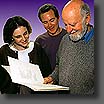

Modern technology might make books obsolete. Each semester, six Berkeley students take a course that treasures the book and 19th century technology.
The course--"The Hand-Printed Book In Its Historical Context"--was launched in 1982 by the Bancroft Library to take advantage of its 1856 Albion hand press and collection of printing fonts. Officially known as Visual Studies 185, the course is made possible by the Norman H. Strouse Fund for the Art and History of the Book.
The two-unit course, limited to six students, meets weekly in Bancroft's press room. Lectures on the history of printing, including typography, paper, binding, and illustration, are followed by hands-on production of a short text from Bancroft's collections.
This spring, under the direction of Bay Area fine printer Peter Rutledge Koch, the class hand-set, printed, and bound 35 copies of an unpublished poem by Lawrence Ferlinghetti.
Other class projects have included works by Richard Brautigan and the University's Gary Soto, and a translation of a letter sent from the New World to Spain in 1541.
"This course is like teaching Latin," says Koch. "This is the language out of which all printing has come, including today's desktop publishing."
Terms like leading (rhymes with bedding), font, point, pica, and upper case/lower case date back as far as the 16th century. The expression "mind your p's and q's" is an old typesetting admonition.
Koch says Berkeley students don't know how lucky they are to have the equivalent of a working 19th-century printing shop and access to one of the finest rare book collections in the world.
"Bancroft is one of the great treasure houses of the West," says Koch. "Many of the greatest monuments of printing are here, including a leaf from the Gutenberg bible. Through this course, students are exposed to a world usually only available to those in the antiquarian book trade and advanced scholars."
